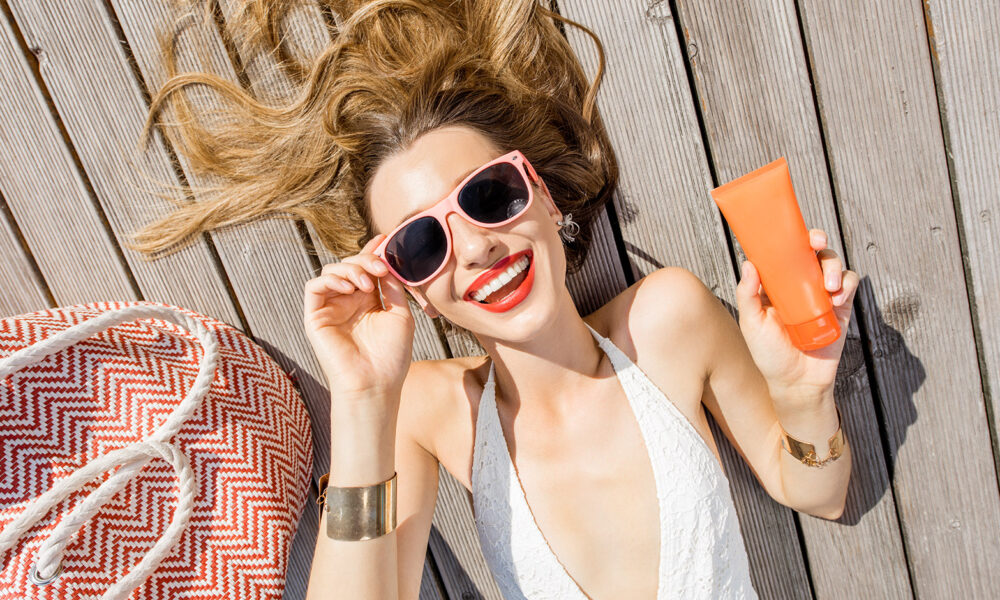

Deciphering the code of caring for your skin
We all know that beautiful skin is an essential part of being glamorous. Our skin is the biggest organ we have and it is susceptible to mistreatment from many factors in our life. We love the sun and our bodies crave the Vitamin D that it provides, but balancing a healthy glow and avoiding damage can be tricky.
Those of us concerned with our skin’s health, elasticity, and youthful appearance often use a combination of methods, including protective clothing, utilizing shade, fun hats and glasses, and of course, sunscreen. But it turns out that the sun’s harmful rays aren’t the only danger we need to dodge in our quest for perfect skin. The very thing that is meant to protect us, our sunscreen, usually has toxic chemicals in it, and could easily be contributing to premature aging and skin damage, causing us additional harm. So, here’s the skinny on the key ingredients in most sunscreens.
Most sunscreens contain toxic chemicals
Out of 2,000 sunscreens tested, the Environmental Working Group (EWG) found that more than 75% contain toxic chemicals that can increase your risk of cancer and other health issues. Most sunscreens contain oxybenzone and butylparaben, both of which are listed as moderate to high “overall concern” for health hazards by the EWG.
Oxybenzone is a particularly penetrative chemical that raises concerns of biochemical or cellular level changes and endocrine disruption. It also happens to be the most common allergen found in sunscreens . and the allergic reactions are triggered by sun exposure.
Butylparaben is an antimicrobial preservative and has been found to cross body barriers and enter the body through the lungs, GI tract, and skin epithelium (National Toxicological Program). And according to the International Chemical Secretariat, butylparaben may also decrease sperm function and alter metabolic hormones.
These are not the only ingredients to run from either. There is a long list of confusing, difficult to pronounce chemicals that we don’t want on our skin – or put into the environment around us. So what about harming the world around us?
Your sunscreen may be harming marine life
You may think that you alone, with a thin layer of standard sunscreen can do no harm.
But it turns out this is untrue. A study published in the Archives of Environmental Contamination and Toxicology found that even a small squirt of sunscreen in six Olympic-sized pools is enough to cause disruption of coral growth, kill coral, and contribute to the increasing rate of coral bleaching. I’ve spared you the details of how it actually does this to the coral, as it broke my heart.
What can you do to protect our coral reefs, sea life, and aquatic ecosystems?
Start by using a reef-safe sunscreen! But as for our own healthy bodies, we must go even further.
There are several categories of sunscreen to choose from; chemical free, organic, natural, and reef safe. So it seems the .≤good news’ is that the level of toxins you enjoy is up to you!
While it can still be very confusing for consumers to untangle all of the different categories and claims made by manufacturers, one thing is for sure … we believe the more natural, the better for us.
Keeping it Real – Real Natural
Plant-based ingredients are becoming more viable options for sunscreen manufacturers in creating UV-protection, and they are choosing them over chemicals.
When you are looking for that new sunscreen, keep in mind that natural sunscreens utilize zinc oxide and titanium oxide to help block the UVA & UVB rays. So know these components by name when looking, they are required by the new sunscreen regulations.
Toss the Toxic, Nab the Natural
We have done the research, and have even sent our resident redhead, me, out into the sun to test the ones that came out on top. Based on ingredients, protection, and feel, here are our .≤Conscious Consumer Recommendations’ for the most natural, toxic and chemical-free sunscreens.
ALL 3 are, broad spectrum protection, water resistant eco/ reef safe, biodegradable, hypoallergenic, 100% certified natural, non- GMO, cruelty-free, and are either made with recyclable materials
or are recyclable.
Peak SPF 30
is produced in the USA, GMP Compliant, and has strict Quality Control guidelines.
Raw Elements Eco Formula SPF 30+ Sunscreen
is sting free, certified organic, Project Verified, and NPA Certified Natural formula.
Badger Sport Sunscreen SPF 35
is produced in the USA, only has 5 ingredients, 94% Certified Organic, and has been recommended by the EWG.
Now you can enjoy your fun in the sun and feel good knowing your sunscreen is truly protecting you and is safe for the environment at the same time!
Sunscreen Survival Guide
Terms to Know
- “Broad Spectrum” protects against UVB & UVA rays.
- Products can no longer claim they are “sunblock,” because this alleges far more protection that one can possibly offer.
- “Water Resistant“ means it will be effective for up to 40 minutes in the water. “Very Water Resistant” means it will be effective for up to 80 minutes in the water. Neither are “waterproof” or “sweat proof” and should be reapplied after being in the water/ sweating.
- “SPF” stands for Sun Protection Factor and the SPF protects you from UVB rays. An SPF number is not the number of minutes you can stay in the sun, but how many times longer than if you had no protection.
Example: If you burn in 10 minutes, an SPF of 30 would allow you to remain in the sun for 30x longer, 300 minutes, before burning.
Commonly Used Unsafe, Toxic Chemicals in Sunscreen
- Avobenzone
- Butylparaben
- Cinoxate
- Homosalate
- Methylbenzylidene
- Octinoxate
- Octocrylene
- Oxybenzone
- Para amino benzoic acid (PABA)
- Parabens
- Phenylbenzimidazole
- Propylene glycol
- Sodium lauryl sulfate
- Vitamin A
YOU MAY ALSO LIKE
7 Skincare Secrets from around the World






















